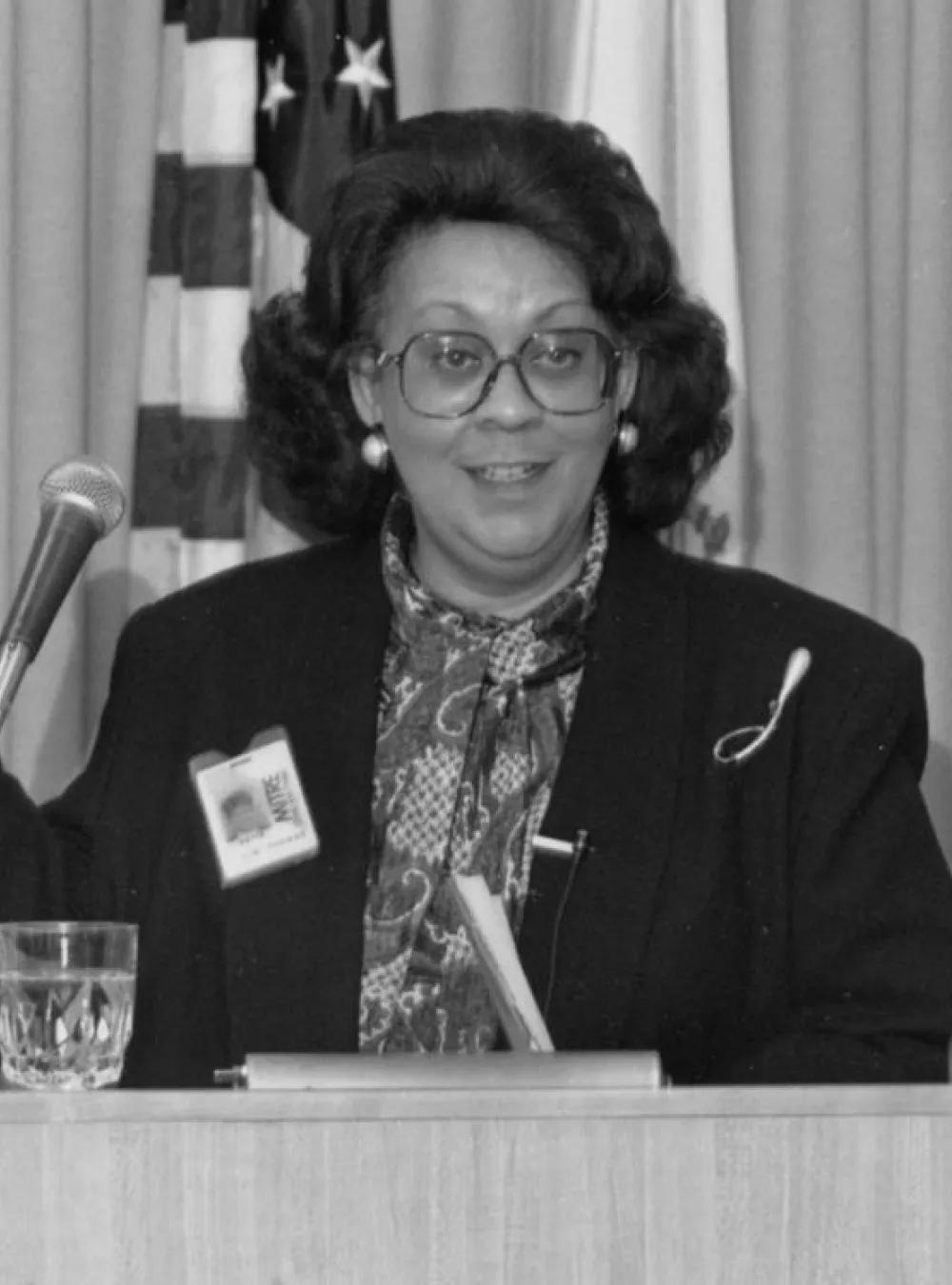Lydia Thomas joined MITRE in 1973—one of few women and even fewer African Americans in a technical role. A cell biologist, she expanded our environmental and health sciences capabilities to support our sponsors' growing needs.

Lydia Thomas: A Pioneer's Perspectives
Lydia Thomas, then SVP and general manager of MITRE's Center for Civil Systems, gives the keynote at Bedford's 1993 Affirmative Action Advisory Committee Forum. (Source: MITRE Corporate Records and Archives)
Lydia Thomas almost lit her kitchen on fire when she was 10 years old. The chemistry experiment gone awry taught Thomas a lesson that guided her throughout her 23-year career at MITRE—and later as president and CEO of Noblis.
“I learned that day that science takes patience,” Thomas says of her attempt to make dye out of flowers, first by putting the petals in water, then in rubbing alcohol, then heating the mixture.
Thomas channeled her love of science and earned a doctorate in cell biology/cytology from Howard University in Washington, D.C. She joined MITRE in 1973 as a technical staff member. At the time, she was one of few women in a technical role and one of even fewer African Americans, male or female, at the company.
Leveraging her life sciences background, Thomas established, grew, and led MITRE’s civilian work in environmental and health sciences for more than two decades. She became the first African American female vice president and later senior vice president and general manager at MITRE.
While a lot has changed since the 1970s, Thomas says one thing hasn't: MITRE's impact.
"The importance of MITRE's work remains critical. It's enduring."
Leading the Way with New Capabilities
Thomas brought a new set of capabilities into the company at just the right time.
“It was the age of [pioneering environmentalist] Rachel Carson, and the EPA had just been established," she says. "For the first time, many MITRE sponsors were navigating requirements for environmental impact statements. They needed to understand the science underneath. I could deliver that.”
Her early MITRE work involved researching alternative methods to control acid mine drainage for the Army Corps of Engineers. She contributed to a range of environmental analyses, including railroad abandonment and large pier construction.
Given that environmental issues affect multiple stakeholders and systems, Thomas built an interdisciplinary team to examine all angles.
“I hired biologists, toxicologists, economists, and engineers,” Thomas says. “We partnered with the Department of Energy, DoD, including the Air Force, Army and Navy, and other agencies with sites around the world to develop solutions to environmental pollution.”
Her team was instrumental in helping the EPA develop the Comprehensive Environmental Response, Compensation, and Liability Act, also known as CERCLA or the Superfund law. The 1980 law held petroleum and chemical industries accountable for hazardous waste pollution and established a trust fund for clean-up when there was no definitive responsible party.
“Although MITRE didn’t get public credit, we were behind much of the science in the Superfund law.”
An Environment for Advancement
She continued to grow in her career, receiving recognition inside and outside the company. For instance, Thomas was appointed by the Chief, Army Corps of Engineers, to the Environmental Advisory Board of the Corps. Thomas was the first African American to hold this position.
Thomas was named vice president of MITRE's Civil Systems Division in 1989, becoming our first Black female executive. And in 1992, she became senior vice president and general manager of the Center for Environment, Resources, and Space. That put her in charge of MITRE's energy, resource, and environment work, as well as space systems activities.
In 1996, Thomas became the second president and CEO of Mitretek Systems (later renamed Noblis), a science, technology, and strategy organization working at all levels of government. She led the not-for-profit for 11 years.
For her extraordinary impact on the field of science, BEYA named her Engineer of the Year in 2003.
STEM as a Language
Thomas came to her science mindset from early childhood. Growing up in the Naval shipyard city of Portsmouth, Virginia, Thomas was always interested in what made things work.
“I’d constantly wonder, why was green green? Why were flowers pink? Hence the experiment,” Thomas says. “I loved trying to recreate things. My chemist father, a high school principal, encouraged me. My mother, a history teacher, didn’t like my experiments as much.”
Thomas leaned on her love of learning to navigate any challenges that came her way.
“I grew up in a segregated school system," she says. "If there was anything you could do to better yourself, you did it. When my homeroom teacher was getting her Ph.D. in mathematics and said to come to school one hour earlier to learn calculus, I did.”
Thomas’ father ignited her interest in science, but she realizes not everyone has that advantage. Unless young children see a love of science at home or in school, Thomas says, it may not happen. The country has a long way to go to get kids, particularly young minority girls, interested in STEM.
“Science and math are like languages. When parents and teachers expose children to STEM early, they learn as easily as a second language when it is a part of everyday life.”
Retired but Still Influential
In retirement, Thomas advances causes she cares about.
She’s on the advisory board of the Posse Foundation, a nonprofit that recruits cohorts of students with great leadership potential and makes college access possible.
She’s on the board of the INOVA hospital system’s Life With Cancer program, which provides free education and wellness programs for cancer patients and their families.
She’s a longtime board member of the United States Energy Association and the Northern Virginia Technology Council.
Thomas’ advice for the next generation of leaders?
“Be serious about what you’re doing, but don’t take yourself too seriously. Don’t be afraid to say 'I don’t know.' It doesn’t mean you’re not capable of knowing it.”
—by Karina Wright